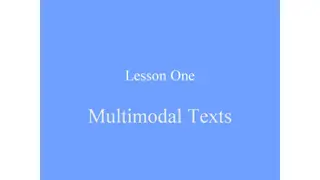
Discovering the Art of Pantomime: History, Techniques, and Principles
Delve into the captivating world of pantomime, an art form rooted in ancient traditions and cherished by iconic performers like Marcel Marceau. Explore the essence of pantomime, distinguish it from mime, and uncover the key principles and techniques that bring silent storytelling to life on stage. From its rich history to practical dos and don'ts, this comprehensive guide illuminates the beauty and power of acting without words.
Download Presentation

Please find below an Image/Link to download the presentation.
The content on the website is provided AS IS for your information and personal use only. It may not be sold, licensed, or shared on other websites without obtaining consent from the author. If you encounter any issues during the download, it is possible that the publisher has removed the file from their server.
You are allowed to download the files provided on this website for personal or commercial use, subject to the condition that they are used lawfully. All files are the property of their respective owners.
The content on the website is provided AS IS for your information and personal use only. It may not be sold, licensed, or shared on other websites without obtaining consent from the author.
E N D
Presentation Transcript
Pantomime Adapted from Christine Wortham
What is Pantomime? Acting without talking Comes from the Greek word pantominios, which means all imitator (imitate all)
Pantomime vs. Mime What is the difference? Mime: The silent art of using body movements to create an illusion of reality. Pantomime: The use of mime techniques, acting without words, to tell a story.
Why Study Pantomime? It is the first phase of acting Body Voice Mind The language of action is universal ACTIONS SPEAK LOUDER THAN WORDS! When all is said and done, acting is telling a story with the body; the words and stagecraft simply embellish what the body says.
History of Pantomime Ancient Greek masks Chinese and Japanese masks Silent movies Charlie Chaplin 1889 1977
Marcel Marceau Born 1923, died 2007 the language of the heart play The Restaurant
Principles of Pantomime Chest is the key Positive emotions = high, expanded, free, broad, animated gestures Negative emotions = tense, contracted, restricted gestures Avoid covering your face while expressing emotion Direct your story to your audience All movement should be clearly motivated Use posture/movements expected of your character Concentrate! Practice! (especially in front of a mirror!)
Principles of Pantomime Creating an object in pantomime Visualize the object. See it in your mind. Approach the object. Move toward it. Take the object. Make contact with it. Tell the audience its location, size, shape, weight. Release the object. Let go. play Chinese Superman play Picking a Flower play drinking from a cup
DOs and DONTs DO DO exaggerate facial expression DO show the shape, size, weight of objects DO focus fully on the task DO show the audience who you are, where you are and what is happening DO plan a beginning, middle and end DO include conflict or a problem TAKE YOUR TIME!!! DON T DON T mouth words (but you can move your mouth as if speaking) DON T make any noise DON T use props DON T include violence, weapons, etc.
Dont forget! Don t mouth words Don t make any noise Don t use props Don t include violence, weapons, etc. TAKE YOUR TIME! Focus! Exaggerate your facial expressions/emotions Exaggerate your gestures/body movements Face the audience! Have a beginning/middle/end Creating an object in pantomime: Visualize, Approach, Take, Tell, Release
Gesture Practice Relief ( Phew! ) Impatience ( You re late! ) Calling someone over ( Come here! ) No, thank you. Excitement ( I can t wait! ) Begging ( Pretty please?!? ) Approval ( That s great! )
Object Practice Talk on the phone Open a can of soda Type on the computer Pick up a pencil Pick up a bowling ball
Lets Make Soup! Have everyone sit in the circle and you have an imaginary pot that you're going to pass around the circle. Tell the kids when they get the pot they can put any ingredient in the soup they want. They have to be sure to keep the shape of the pot, and the heaviness, etc. When they are done putting their ingredient in the pot, they pass the pot to the next person and the class guesses what the item was. They can get creative with their ingredients. It usually starts off with vegetables, etc., but inevitably the kids will start putting other things in there... shoes, snot, hair, etc. When the pot gets back to you, you then tell them they have to TRY the soup. So you pass the pot around again, this time with a spoon, and they have to work on their expressions as they taste the nasty soup. It's super fun and the kids love it. 1. 2. 3. 4. 5.
Individual Pantomimes Keep it Simple! Examples: Walk along the street and get bubble gum stuck to the bottom of your shoe. Try to open your locker. It is jammed. Wash your face and get soap in your eyes. Look for a towel. Put on a pair of shoes that are too tight. You can t find the right key to open the lock on the door. Drink a large glass of water and then discover you have swallowed a bug.

